Contemporary graffiti

Contemporary graffiti style has been heavily influenced by hip hop culture and the myriad international styles derived from Philadelphia and New York City Subway graffiti, however, there are many other traditions of notable graffiti in the twentieth century. Graffiti have long appeared on building walls, in latrines, railroad boxcars, subways, and bridges.
The oldest known example of modern graffiti are the "monikers" found on traincars created by hobos and railworkers since the late 1800s. The Bozo Texino monikers were documented by filmmaker Bill Daniel in his 2005 film, Who is Bozo Texino?.
Some graffiti have their own poignancy. In World War II, an inscription on a wall at the fortress of Verdun was seen as an illustration of the US response twice in a generation to the wrongs of the Old World:
Austin White – Chicago, Ill – 1918
Austin White – Chicago, Ill – 1945
This is the last time I want to write my name here.
During World War II and for decades after, the phrase "Kilroy was here" with an accompanying illustration was widespread throughout the world, due to its use by American troops and ultimately filtering into American popular culture. Shortly after the death of Charlie Parker (nicknamed "Yardbird" or "Bird"), graffiti began appearing around New York with the words "Bird Lives". The student protests and general strike of May 1968 saw Paris bedecked in revolutionary, anarchistic, and situationist slogans such as L'ennui est contre-révolutionnaire ("Boredom is counterrevolutionary") expressed in painted graffiti, poster art, and stencil art. At the time in the US, other political phrases (such as "Free Huey" about Black Panther Huey Newton) became briefly popular as graffiti in limited areas, only to be forgotten. A popular graffito of the early 1970s was "Dick Nixon Before He Dicks You", reflecting the hostility of the youth culture to that US president.
- World War II graffiti

Soldier with tropical fantasy graffiti (1943–1944)

Soviet Army graffiti in the ruins of the Reichstag in Berlin (1945)

Permanent engraving of Kilroy on the World War II Memorial in Washington, D.C.
Advent of aerosol paint
Rock and roll graffiti is a significant subgenre. A famous graffito of the twentieth century was the inscription in the London tube reading "Clapton is God" in a link to the guitarist Eric Clapton. The phrase was spray-painted by an admirer on a wall in an Islington station on the Underground in the autumn of 1967. The graffito was captured in a photograph, in which a dog is urinating on the wall.
Graffiti also became associated with the anti-establishment punk rock movement beginning in the 1970s. Bands such as Black Flag and Crass (and their followers) widely stenciled their names and logos, while many punk night clubs, squats, and hangouts are famous for their graffiti. In the late 1980s the upside down Martini glass that was the tag for punk band Missing Foundation was the most ubiquitous graffito in lower Manhattanaccording to whom?
- Early spray-painted graffiti
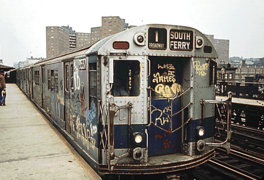
New York City Subway trains were covered in graffiti (1973)
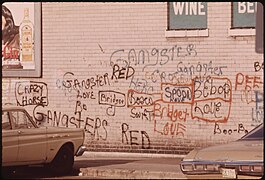
Graffiti in Chicago (1973)
Spread of hip hop culture
In 1979, graffitists Lee Quiñones and Fab 5 Freddy were given a gallery opening in Rome by art dealer Claudio Bruni. For many outside of New York, it was their first encounter with their art form. Fab 5 Freddy's friendship with Debbie Harry influenced Blondie's single "Rapture" (Chrysalis, 1981), the video of which featured Jean-Michel Basquiat, and offered many their first glimpse of a depiction of elements of graffiti in hip hop culture. JaJaJa toured Germany, Switzerland, Belgium, and Holland with a large graffiti canvas as a backdrop. Charlie Ahearn's independently released fiction film Wild Style (Wild Style, 1983), the early PBS documentary Style Wars (1983), hit songs such as "The Message" and "Planet Rock" and their accompanying music videos (both 1982) contributed to a growing interest outside New York in all aspects of hip hop.
Style Wars depicted not only famous graffitists such as Skeme, Dondi, MinOne, and ZEPHYR, but also reinforced graffiti's role within New York's emerging hip-hop culture by incorporating famous early break-dancing groups such as Rock Steady Crew into the film and featuring rap in the soundtrack. Although many officers of the New York City Police Department found this film to be controversial, Style Wars is still recognized as the most prolific film representation of what was going on within the young hip hop culture of the early 1980s. Fab 5 Freddy and Futura 2000 took hip hop graffiti to Paris and London as part of the New York City Rap Tour in 1983. Hollywood also paid attention, consulting writers such as PHASE 2 as it depicted the culture and gave it international exposure in movies such as Beat Street (Orion, 1984).
Stencil graffiti emerges
This period also saw the emergence of the new stencil graffiti genre. Some of the first examples were created in 1981 by graffitists Blek le Rat in Paris, in 1982 by Jef Aerosol in Tours (France);citation needed by 1985 stencils had appeared in other cities including New York City, Sydney, and Melbourne, where they were documented by American photographer Charles Gatewood and Australian photographer Rennie Ellis.
- Stencil graffiti

Political graffiti in Cancun, Mexico (2007)
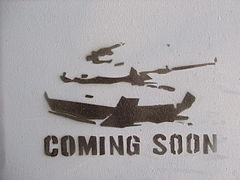
Modern stencil graffiti, a very common style, in Toronto, Ontario, Canada
Commercialization and entrance into mainstream pop culture
With the popularity and legitimization of graffiti has come a level of commercialization. In 2001, computer giant IBM launched an advertising campaign in Chicago and San Francisco which involved people spray painting on sidewalks a peace symbol, a heart, and a penguin (Linux mascot), to represent "Peace, Love, and Linux." IBM paid Chicago and San Francisco collectively US$120,000 for punitive damages and clean-up costs.
In 2005, a similar ad campaign was launched by Sony and executed by its advertising agency in New York, Chicago, Atlanta, Philadelphia, Los Angeles, and Miami, to market its handheld PSP gaming system. In this campaign, taking notice of the legal problems of the IBM campaign, Sony paid building owners for the rights to paint on their buildings "a collection of dizzy-eyed urban kids playing with the PSP as if it were a skateboard, a paddle, or a rocking horse".
Advocates
Marc Ecko, an urban clothing designer, has been an advocate of graffiti as an art form during this period, stating that "Graffiti is without question the most powerful art movement in recent history and has been a driving inspiration throughout my career."
Graffiti have become a common stepping stone for many members of both the art and design communities in North America and abroad. Within the United States graffitists such as Mike Giant, Pursue, Rime, Noah, and countless others have made careers in skateboard, apparel, and shoe design for companies such as DC Shoes, Adidas, Rebel8, Osiris, or Circa Meanwhile, there are many others such as DZINE, Daze, Blade, and The Mac who have made the switch to being gallery artists, often not even using their initial medium, spray paint.
Global developments
South America
Tristan Manco wrote that Brazil "boasts a unique and particularly rich, graffiti scene ... earning it an international reputation as the place to go for artistic inspiration." Graffiti "flourishes in every conceivable space in Brazil's cities." Artistic parallels "are often drawn between the energy of São Paulo today and 1970s New York." The "sprawling metropolis," of São Paulo has "become the new shrine to graffiti;" Manco alludes to "poverty and unemployment ... and the epic struggles and conditions of the country's marginalised peoples," and to "Brazil's chronic poverty," as the main engines that "have fuelled a vibrant graffiti culture." In world terms, Brazil has "one of the most uneven distributions of income. Laws and taxes change frequently." Such factors, Manco argues, contribute to a very fluid society, riven with those economic divisions and social tensions that underpin and feed the "folkloric vandalism and an urban sport for the disenfranchised," that is South American graffiti art.
Prominent Brazilian graffitists include Os Gêmeos, Boleta, Nunca, Nina, Speto, Tikka, and T.Freak. Their artistic success and involvement in commercial design ventures has highlighted divisions within the Brazilian graffiti community between adherents of the cruder transgressive form of pichação and the more conventionally artistic values of the practitioners of grafite.
Middle East
Graffiti in the Middle East is emerging slowly, with pockets of taggers operating in the various 'Emirates' of the United Arab Emirates, in Israel, and in Iran. The major Iranian newspaper Hamshahri has published two articles on illegal writers in the city with photographic coverage of Iranian artist A1one's works on Tehran walls. Tokyo-based design magazine, PingMag, has interviewed A1one and featured photographs of his work. The Israeli West Bank barrier has become a site for graffiti, reminiscent in this sense of the Berlin Wall. Many graffitists in Israel come from other places around the globe, such as JUIF from Los Angeles and DEVIONE from London. The religious reference "נ נח נחמ נחמן מאומן" ("Na Nach Nachma Nachman Meuman") is commonly seen in graffiti around Israel.
Southeast Asia
There are also a large number of graffiti influences in Southeast Asian countries that mostly come from modern Western culture, such as Malaysia, where graffiti have long been a common sight in Malaysia's capital city, Kuala Lumpur. Since 2010, the country has begun hosting a street festival to encourage all generations and people from all walks of life to enjoy and encourage Malaysian street culture.
- Graffiti around the world

Graffiti on a wall in Čakovec, Croatia
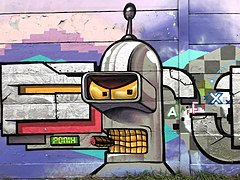
Graffiti of the character Bender on a wall in Budapest, Hungary
Graffiti in Ho Chi Minh City, Vietnam
Graffiti art in Kuala Lumpur, Malaysia
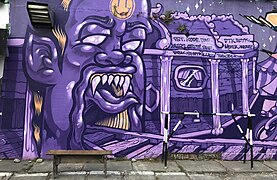
Graffiti in Yogyakarta, Indonesia

Graffiti on a park wall in Sydney, Australia









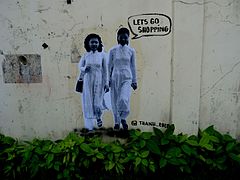



Comments
Post a Comment